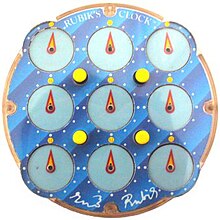
The Rubik's Clock is a mechanical puzzle invented and patented by Christopher C. Wiggs and Christopher J. Taylor.[1] The Hungarian sculptor and professor of architecture Ernő Rubik bought the patent from them to market the product under his name. It was first marketed in 1988.
The Rubik's Clock is a two-sided puzzle, each side presenting nine clocks to the puzzler. There are four dials, one at each corner of the puzzle, each allowing the corresponding corner clock to be rotated directly. (The corner clocks, unlike the other clocks, rotate on both sides of the puzzle simultaneously and can never be operated independently. Thus the puzzle contains only 14 independent clocks.)
There are also four pins which span both sides of the puzzle; each pin arranged such that if it is "in" on one side it is "out" on the other. The state of each pin (in or out) determines whether the adjacent corner clock is mechanically connected to the three other adjacent clocks on the front side or on the back side: thus the configuration of the pins determines which sets of clocks can be turned simultaneously by rotating a suitable dial.
The aim of the puzzle is to set all nine clocks to 12 o'clock (straight up) on both sides of the puzzle simultaneously. The method to do so is to start by constructing a cross on both sides (at 12 o’clock) and then solving the corner clocks.
The Rubik’s clock is listed as one of the 17 WCA events, with records for fastest time to solve one puzzle, and the fastest average time to solve 5 puzzles (discarding the slowest and fastest times).